|
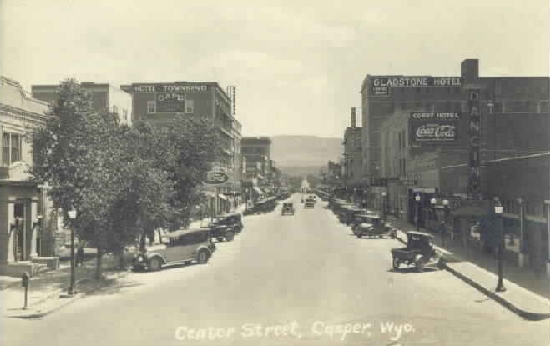
Center Street, Casper, approx. 1920, looking south.
At the intersection of Center and First Street were three of Casper finest hotels, the Gladstone on the right,
past the Gladstone was the Henning, discussed on a previous page. The vertical sign on the
right side of the street next to the pickup truck advertises "Dancing." The building is the
Arkeon Dancing Acadamy. See views lower on page. Dances were also held at Washington Hall and Joy Land.
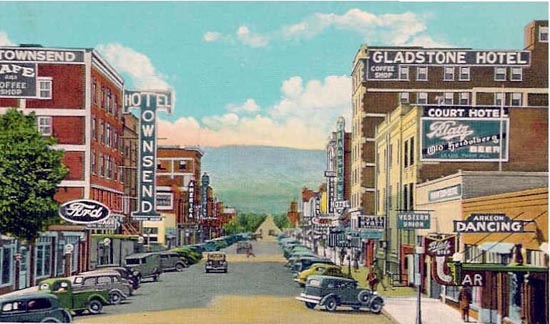
Center Street looking south, approx. 1938.
On the left is the Townsend Hotel which boasted of 135 guest rooms, a billiard room in the basement and, after Prohibition ended,
the Tomahawk Bar. During World War II, the Townsend housed an officers' club in the basement. The ballroom in which a band played was the "Honeycomb Room."
One musician who played at the Townsend was Howard Fordham from Kansas who played in the 1940s thrughout the midwest from
Oklahoma north to Montana.
The Townsend is now on the National Register but after it closed in 1982, sat until 2008 forlorn,
inhabited only by pigions. The hotel was designed
by architect Arthur M. Garbutt. Garbutt arrived in Casper in 1912 from Fort Collins.
In addition to the Townsend, Garbutt designed St. Anthony's at the corner of
7th and Center, the old Natrona High School, the Elks Lodge, and the Roosevelt School.
In Fort Collins, Garbutt designed the nucleus of the present Elks Lodge and worked with
architect Montezuma Fuller in the design of the YMCA. The Gladstone Hotel on the right was famous for its
Crystal Ball Room.
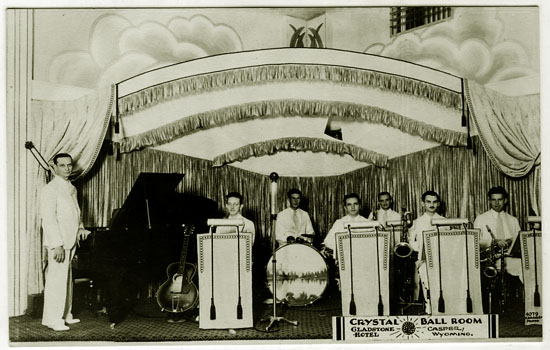
Band, Crystal Ballroom, Gladstone Hotel. Photo by Thomas Carrigen.
It has been said that in the 1950's on a Saturday evening one could walk down Center Street and not be out of earshot of a band playing in one of the
big hotels or the Petroluem Club. One of the more popular bands was saxaphonist Chick Erickson's eight-piece band, "Erickson and His Music Markers."
The band usually played the sounds of
the "big bands" so much so that Erickson's band eventually became known as the "Little Big Band" under the leadership of
Laurel Wirth. One evening about early 1956, the band deviated from its usual formula of big band and played a popular Ernest Tubb country and western
number. Wirth told the audience that it was James Alexander's favorite song.
Undoubtedly some of the dancers had taken the 48-year old pudgy, balding former shop instructor's classes at
Natrona County High School, but everyone knew who Jim Alexander was.
Several years before Jim had divorced his wife
Rose and married a younger woman Barbara.
Barbara was about 20 years Jim's junior. But following the divorce, Rose, Barbara, and Alexander continued to live together in Jim's house
in east Casper. When Barbara became pregnant, Rose moved into a trailer house owned by Alexander. He, however, continued to visit Rose at
the trailer.
. On June 18, 1953, Barbara disappeared. The next day Rose moved back into the main house. Jim nailed the door to the basement
shut. Two days later Jim left town. Alexander did not report Barbara's
disappearance until the following March. The police initially treated the case as just another missing
person report. Alexander claimed that he did not know where
Barbara was; that he thought that she had decided to leave him. He remarried Rose. After Barbara's parents living in Hardin, Montana complained,
the police began to believe that Barbara might have been "done in" and placed Jim under survailance.
On December 7, the citizens of Casper learned the sordid details of Barbara's disappearance.
In December 1955, Alexander, for an unknown reason, finally consented to
a search of his basement. Police already knew that there was an area of the basement measuring about
seven feet by twenty-four feet in which the concrete floor was cracked and did not match in color the rest of the
floor. There was a glitch at the
time in Wyoming law. Police with reasonable grounds to believe, as an example, that one is storing illegal
hootch in one's basement, may obtain a search warrent. The law did not, however authorize a search warrent for
stashed body in one's basement. In the basement, investigators, an attorney, a photographer, Rose and Jim watched as
the investigators using a jack hammer excavated the discolored area. They broke through over four inches of concrete. But nothing was found. A shocked look
came over Rose's face. Jim made, according to the police, a slight nod to the east. The floor where Jim had nodded to was broken through
again. Four inches below the bottom of the concrete in a plastic sheet filled with more cement skeletal remains were found. The
skeleton clutched a crude wooden cross against its breast bones.
Rose told the coroner's jury, that Barbara had accidently fallen into an open excavation and that a pile of stacked bricks had
fallen on her. She had, Rose said, placed the cross in Barbara's hands as a "religious observance." The body was placed on a bed of
dry bagged cement in that it would make a soft bed. Investigation indicated that the cement had been wet down. She did not report the "accident"
because, she said, it would hurt the children. Rose was arrested and bond set at
$10,000. Jim posted bond for his wife and immediately thereafter he was arrested on a charge of first degree murder.
Rose later testified that Jim had poured the concrete floor. Jim testified that he knew nothing of
Barbara's demise until the skeleton was found.
With the notoriety, trial was moved to Cheyenne.
There, slowly and methodically the State built its circumstantial case in front of a jury of seven men and five women. Testimony
revealed that in June, 1953 prior to Barbara's disappearance, Jim raised the water meter in his basement so it could be read from
outside the basement window He also had Barbara sign some blank conveyancing deeds.
Jim told various
persons different stories about Barbara's absence: Barbaa was dead;
she was lying in dry cement and lime; she had left him; she had threatened suicide; he had
seen her on the street; he dreamed she had come to him; when he slept in the basement he felt
close to her; the police or other authorities were searching for her and he made several other
statements tending to account for her disappearance. In the fall of 1953, the defendant said in a letter,
"Never do I feel as near my beloved Barbara as when I sleep in my basement". When an acquaintance
told him officers thought he had Barbara in a pit he was digging, defendant replied, "I don't have her in the pit, I have her in the basement". Although he had written Barbara's parents on September 5, 1953, that Barbara had taken a vacation from "home and marriage", thereafter he wrote them postcards signed "The Alexanders" and later he went to their home in Montana. Not finding her parents there, he left a note saying, "We have been here but couldn't wait. Sorry. The Alexanders", thus leaving it open to inference that Barbara had been there with him. Defendant also voiced his suspicion that Barbara was "chippying" on him and had said he was going to get even with that "two-timing bitch". Defendant also said, "I am going to get rid of that two-timing bitch", and when told he could not get away with it replied, "I can get away — Oh, I can, I can get away with anything" and repeated
"I can get away with anything". When punishing one of the children he said he ought to kill
the mother. He boasted of his ability to kill with one blow; said he wanted a skeleton;
offered to do away with another person for his tenant, and told about the most perfect crime
being committed where the perpetrator was supposed to have buried his wife in concrete .See Sate v. Alexander,78 Wyo. 324; 324 P. 2d 831 (1958).
Thus it was that with a macabre sense of humor, the Little Big Band played Ernest Tubb's country and western "I'm Walking the Floor Over You."
Jim was found guilty of second degree murder and sentenced to no less than 45 years nor more than 65 years in the State Penitentiary.
In sentencing Alexander, Judge Sam M. Thompson compared Rose to a "brainwashed prisoner of war."
The judge's observation was later borne out by a psychiatric examination of Rose which resulted in the
Prosecutor dropping charges against her. Alecander's subseqent appeal was denied, see State v.Alexander, supra.
A petition to the federal court was denied as was a pro se (by one's self without a lawyer) appeal from that determination. See Alexander v.
Daugherty, 286 F. 2d 645 (1961)
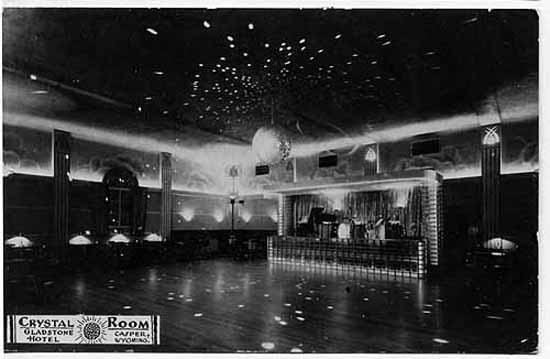
Bandstand, Crystal Ballroom, Gladstone Hotel. Photo by Thomas Carrigen.
The Gladstone was constructed in 1923 by Charles A. Smith and his wife Phyetta Smith. Following the end of
prohibition, a bar and lounge was added to the hotel. Their son C. Hampton Smith joined his parents in the
operation of the hotel.
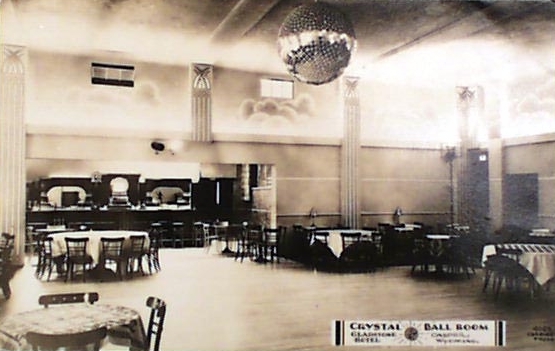
Bar, Crystal Ballroom, Gladstone Hotel. Photo by Thomas Carrigen.
In 1954, rennovations were made to the facility including a nine-story addition topped by the "Sky Room." The hotel was thereafter referred to in
advertising as the "New Gladstone."
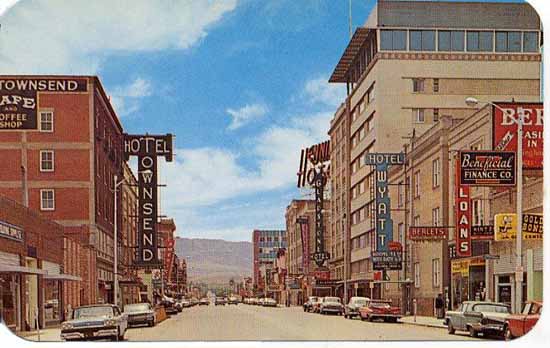
Center Street, Casper, looking south, approx. 1960, Photo by William P. Sanborn, courtesy of Stephen Quinlan. On the right beyond the Wyatt is the nine-story additon to the Gladstone with the
Sky Room on top.
Compare the Townsend with the photo of the Townsend lower on the page, forelorn with windows broken out. The two one-story
buildings on the left are gone and the area is a parking lot. But there was hope, hope in the form of
adaptive reuse as a judicial center.
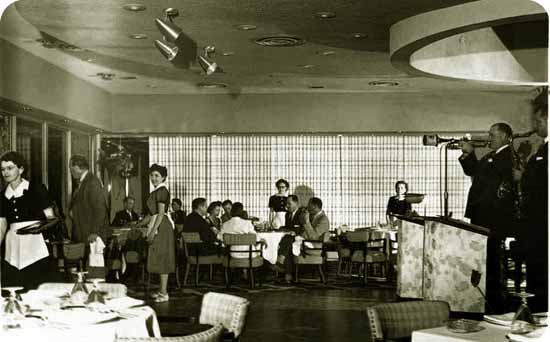
Interior of Sky Room, Gladstone Hotel, 1955.
In 1961 was
property was sold to Dr. Harry Stuckenhoff and Jack Perry.
In 1965, Dr. Stuckenhoff bought out his
partner Perry and, in turn, sold the property to Earl Johnson, Sr. and Earl Johnson, Jr. The Johnsons within a
year defaulted on the mortgages and in 1967 foreclosure proceedings were brought and the hotel went into receivership. After several years
of litigation, including two appeals to the Wyoming Supreme Court, the only part of the hotel
operation deemed to have any economic value was the liquor license. The original part of the hotel was razed and the addition was converted into an office building. But the original part
did not go quietly into the night. The crane operator running the wrecking ball gave a mighty swing against the building. Nothing happened.
Another swing at a different angle only dislodged a few bricks. The crane was raised higher and the wrecking ball given a greater drop.
The chain and the wrecking ball broke.
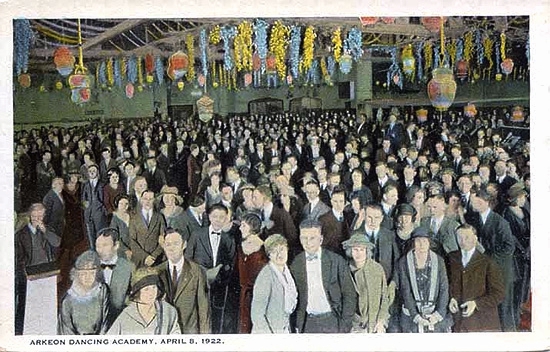
Interior, Arkeon Dancing Acadamy, 1922.
The Arkeon is gone now. The days of the grand hotels on Center Street have passed. The Gladstone and
the Henning have been razed. No longer can one sit in the public rooms as the movers and shakers of Casper pass through. Instead,
out on I-25 are the ubiquitous franchise hotels in which the only occasion to sit in the lobby is in
the morning for the free continental breakfast.
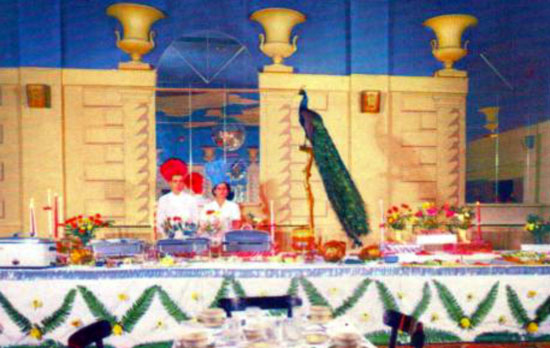
Gladstone Hotel Tuesday Night Buffet.
No longer may one dine in the Little Peacock Room of the
Gladstone, enjoy its Tuesday night buffet or bend an elbow in the Elbow Room of the Henning Hotel. Instead, as the sun sets
in the west and the wind springs up, one may cross a parking lot to a themed franchise restuarant out on an
interchange of the Interstate. The restaurant will feature the
same menu and "new" items in Casper as featured in all of the other restuarants in the chain. The "new" items are, of
course, all carefully designed to conceal price increases.
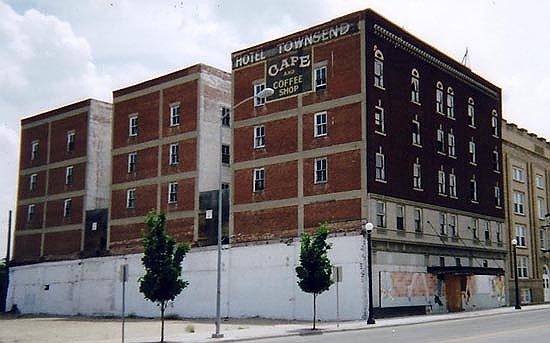
Townsend Hotel, 2005. Photo by Geoff Dobson
In the 2004 Election, the populace voted on a
proposition to convert the building into a judicial center financed by an
addition to the sales tax. The existing courthouse was overcrowded with only two courtrooms for
three judges. Of the two courtrooms, only one was suitable for a jury trial. The proposition
was defeated. Nothwithstanding the defeat at the polls in July 2007, the Board of County
Commissioners purchased the hotel for $1,230,000.00 As of October 2007, the cost of renovation into a new
Judicial Center was estimated to cost between $22,000,000.00 and $24,000,000.00. Ultimately after another electoral
defeat, the County proceeding with the renovation which cost an estimate $25,000,000. In the Spring of
2009 as renovation proceeded another controversy arose over the "Hotel Townsend Ghost Sign" on the
side of the building. One member of the Development Authority indicated that he
thought the sign was "crappy." Others believed that the sign was a remberance of the history of
downtown Casper when it was dominated by "grand hotels," all of which are now gone. In June, 2009. the
Board of County Commissioners authorized the sign to remain. Renovation
put the county into compliance with state law requiring a courtroom suitable for a 12-person jury trial
for each district judge. The front of the building has been modernized and a building constructed in the former
vacant lot to the hotel's north.
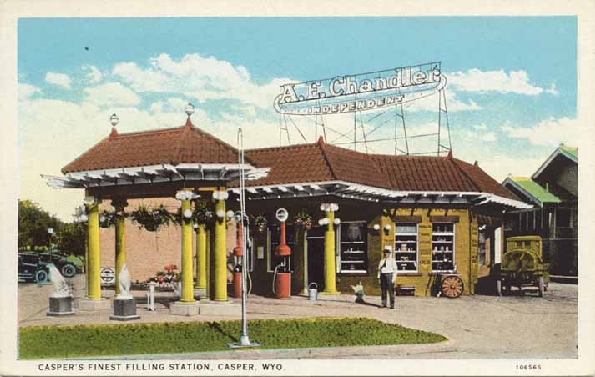
A. E. Chandler's Service Station.
Music this page, "I'm Walking the Floor Over You," courtesy Horse Creek Cowboy Band.
North Platte Photos continued on next page.
|